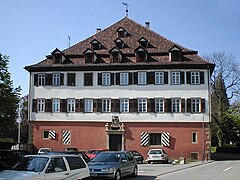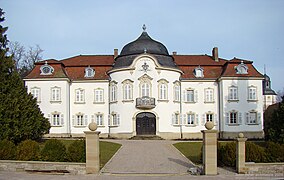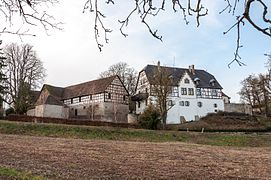Berlichingen (noble family)
The Berlichingen (also Lords of Berlichingen ) is the name of an old noble family . They were imperial knights of Franconian origin with the parent company Burg Berlichingen , whose medieval rule was in the Swabian-Franconian border area and whose most famous representative was Götz von Berlichingen through Goethe's play of the same name . Among the Berlichingen's possessions once one Burg Hornberg in Neckarzimmern and is still one of the Götzenburg called Jagsthausen , besides also in Jagsthausen located manors Red Castle and White Castle and Castle Rossach in Schöntal .
ancestry
The eponymous place Berlichingen is mentioned in the Lorsch Codex in the year 800. The family chronicle of the Berlichingens therefore sees a justification for assuming that ancestors of the family lived there already at that time. The family chronicle of 1861 reports that “the ancestors of the sex also lived here back then, but according to the custom of that time only called each other by their first names, and we believe we have the right to give room to the assumption that the sex which "von Berlichingen" has enjoyed its existence for almost eleven hundred years. "
Accordingly, the oldest Berlichingen would be an Arnold with his “housewife” Landrad (or von Seckendorff). Together they would have donated an anniversary and some masses in the Eberbach monastery in 927 and "given" an estate in Langenzenn and still lived in 950. Both were buried in the church of the monastery. They raised five children named Agnes, Arnold, Mechthild, Friedrich and Berchtold . The chronicle also reports that Friedrich crossed the sea with the knighthood without returning. Bechthold died unmarried and Arnold II . appears as ancestor, followed by Friedrich I and a Friedrich II , although this ancestral series is only mentioned by a Bucelinus in "Germania topo-chronost" in the middle of the 17th century without reference to its sources. There are also reports of an Otto who took part in the first crusade in 1096 and stayed in the Orient . A Berenger von Berlichingen is said to have fought at the crusade of Godfried von Bouillon in Jerusalem around 1099 .
The family names Husen (Hausen) and Bittigstatt ( Wittstatt ), which appear as witnesses in a deed of donation around 1090, and some more are said to have come from the Berlichingen family. Sometimes they also use the same coat of arms as the Berlichingen.
history



After a time gap, the first written, although not documentary, information in the chronicle of the Schöntal monastery dates back to around 1151. After that, a Wolfram von Bebenburg intended to found a monastery. According to a vision, however, he no longer wanted to found this on his own land, but down in the "beautiful valley" in an area of Engelhardt von Berlichingen . Wolfram then had his mother, who was born in von Berlichingen, ask Engelhard von Berlichingen for permission to build the monastery. Engelhard granted this and made the area available free of charge, but with the condition:
... that so often one of Berlichingen leaves with death, the abbot and the convent should be obliged to have the dead fetched with a team of beers, when the corpse arrives at the monastery gate, to accompany him to the church in processions, to adhere to the usual requien and finally buried in the cloister of the monastery - which will be given to the von Berlichingen family as a grave burial for everlasting times.
This was maintained until shortly after the Reformation . So the Schöntal Monastery in Schöntal could finally be built. The descent of Wolfram von Bebenburg's mother from the Berlichingens is not certain and has been partly doubted. However, this possibility is seen as supported by a later file find in the archives of Jagsthausen Castle.
In older chronicles a Frechhans is mentioned around 1165 as the progenitor of the von Berlichingen family, in connection with the tenth tournament "zu Zürich an der Limat". Engelhard I , mentioned above around 1151, can be seen in the more recent family chronicles as the first sure progenitor. In 1157, according to the Schöntaler monastery chronicle, he was also present when Wolfram von Bebenburg had himself dressed as a monk in the monastery and is named as the second donor, since he donated land. His son Engelhard II is mentioned around 1194. The line can then be continued without any gaps. From around the middle of the 14th century, beginning with the Dörzbach-Laybach main line, various branches and main lines can be reliably identified.
Towards the end of the 14th century the Berlichingen acquired the castle in Jagsthausen from its founder, the von Husen . After the construction of further manor houses, the castle was also referred to as the Old Castle or, based on Goethe's drama, which has been performed there since 1950, as Götzenburg .
Around 1430 a significant feud of Hans von Berlichingen , who at that time already owned half of the later Götzenburg Hornberg for a short time, was reported together with some princes and knights against von Horneck zu Hornberg the old . It was about "Murder, Burn and Singe". But it ended with an amicable verdict from five referees who sentenced von Horneck zu Hornberg to pay 3800 Thalers , of which the Berlichingens received 150 Thalers .
In 1441, the Dörzbach-Laybacher and the Bavarian two main Berliching lines bloom alongside the Jagsthausen main trunk, which was continued with the birth of Kilian in the same year. Due to the early death of his father, Kilian, while still a minor, inherited a rich property and also knew how to expand it through clever acquisitions. He was married three times, first to Barbara von Wolmershausen, followed by Elisabeth von Steinau-Steinrück and Margaretha von Thüngen . With these three women he had five daughters named Margaretha, Maria, Helene, Amalia and Lucia as well as five sons: Kilian, Philipp, Hans, Hans-Wolf and finally Götz von Berlichingen, the youngest son from his third marriage and later famous knight with him the Iron Hand , which from then on would shape the Berlichingen family history like no other.
Götz von Berlichingen was born in 1480 or 1481. No documents are known for the place of birth. The family chronicle assumes Jagsthausen to be the place of birth, but the community of Schöntal also claims Götz's birthplace in the Berlichingen district. It is certain that Götz spent a few years of his youth at the castle in Jagsthausen. In 1517 he bought Hornberg Castle and founded the main Hornberg-Rossach line with his eldest son Hans-Jakob, born in 1518. He and his descendants have since signed with von Berlichingen zu Hornberg . In contrast to Goethe's Götz, the real Götz was never lord of the Jagsthausen castle. Götz died in 1562 at Hornberg Castle and his sons and grandchildren began to transform the castle into a contemporary castle through extensive construction work while he was still alive. Around 1500 extensive renovations and new buildings were also carried out at Jagsthausen Castle.
The many feuds and quarrels that Götz led were partly supported by his brothers. Götz and his brother Philipp, for example, were several times henchmen of the robber baron Hans Talacker von Massenbach . The brothers felt the imperial outlook, some of which were also pronounced against them. In 1512, a pseudo sale of Berliching's property to Götzen's companion Conz Schott von Schottenstein is known, who, albeit unsuccessfully, was supposed to save the property from an imperial mandate that denied them the goods. Götz was also remotely related by marriage to Conz through his maternal Thüngen family.
Götzen's oldest brother Kilian entered the Teutonic Order . Philipp, the second oldest, was like his brother Hans in the service of Ulrich von Württemberg and was enfeoffed with Siebeneich . The younger brothers eventually shared the property, with Götz receiving Rossach, among others, but probably never staying there longer; Nevertheless, around 1540 he had Rossach Castle built there, which is still used as a family residence today. Brother Hans-Wolf got Jagsthausen Castle and continued the main line there, whose line, however, died out with his son Thomas in 1568. With his death, the holdings of the family line were then essentially divided between the descendants of Götz and his brothers, with the result that Götzen's grandson Hans Reinhard came back into possession of part of Jagsthausen.
Hornberg Castle was owned by the Berlichingen until 1594. After an uprising by the peasants in Neckarzimmern in 1591 because of the frequent compulsory labor , which also led to complaints from the emperor, Philipp Ernst von Berlichingen sold the castle in 1594 to the electoral Mainz councilor Hans Heinrich von Heußenstamm , who after further unrest among the population and the Death of his son in July 1612 to the Palatinate councilor Reinhard von Gemmingen the scholar (1576-1635) sold.
Count Friedrich Wolfgang Götz von Berlichingen-Rossach writes about Philipp Ernst in his family chronicle from 1861: Unfortunately, through him, the beautiful Hornberg with the village Zimmer in 1602 with feudal consens from the bishopric of Speier, bought to Heinrich von Heußenstamm and thus Götzen's famous castle, came into stranger hands. This is a loss that we cannot get over to this day any more than that of Schrozberg ! The Hornberg and its rooms are currently owned by the Barons of Gemmingen . While Philipp Ernst was selling his most beautiful property, he made no further acquisition than that of the insignificant hamlet of Korb in 1606.
Götzen's grandson Hans Reinhard, who received part of the Jagsthausen estate in 1571, built the Red Castle in Jagsthausen in 1591 . Philipp-Adam von Berlichingen built Sennfeld Castle in 1713 . The White Castle in Jagsthausen was built in 1792 by Count Joseph von Berlichingen.
In 1730 Götzens biography went to print and in 1771 Goethe wrote his drama Götz von Berlichingen , in which the historical Götz provided the model for the main character. Franziska von Berlichingen, née Countess von Hadik, succeeded in acquiring Götz's lost Iron Hand from a gentleman von Hornstein in 1788 . She made them available to the family as inalienable common property. Count Friedrich Wolfgang Götz von Berlichingen-Rossach created an extensive, 778-page story about Götz and his von Berlichingen family. In 1861 this work was published as a book with some pictures, copies of old manuscripts, sketches of the Iron Hand and the family tree of the Berlichingen family until 1861.
From 1876 to 1878 Jagsthausen Castle was redesigned in a historicizing style based on plans by the Ulm minster builder August von Beyer. Every year between June and August since 1950, Goethe's drama has been performed on an open-air stage at the Jagsthausen Castle Festival in the courtyard of the castle, which has since been called Götzenburg .
Several Berlichingen lines are still in bloom today and live mainly in and around Jagsthausen, for example in the Old Castle , the White and Red Castle and Rossach Castle . The last big event was the wedding of Alexandra Freifrau von Berlichingen (née von Vultejus) with former Federal President. D. Roman Herzog in 2001.
Jagsthausen Castle (also "Old Castle" or "Götzenburg")
Red Castle in Jagsthausen
White Castle in Jagsthausen
Rossach Castle, Schöntal
coat of arms
The coat of arms shows a silver five-spoke wheel on a black shield. On the helmet with black and silver blankets a seated silver wolf with a silver lamb in its throat.
Basically the Berlichingen have this five-spoke wheel in their coat of arms, but there are also Berlichingen coat of arms wheels with six spokes, as the stained glass with the coat of arms of Philipp Ernst von Berlichingen-Hornberg shown above clearly shows. Just like the coats of arms of the neighboring Prince-Bishops of Mainz not only had the usual six-spoke wheel, but also heraldic wheels with more, say eight spokes. The positioning of the five-spoke wheel is shown differently, occasionally it is rotated by an angle of 36 degrees.
The Berlichingen coat of arms and the well-known Götz motif of the Iron Hand were also used by the municipality in 1935 in the design of today's coat of arms of Jagsthausen with the consent of the archive management.
Historical coats of arms
Family coat of arms of those of Berlichingen in Scheibler's book of arms
Coat of arms graphic by Otto Hupp in the Munich calendar of 1901
Jagsthausen municipal coat of arms
Berlichingen municipal coat of arms
Lines of family

- I. line (Rossach) (ev. And cath.)
- enrolled in Bavaria and extinct
- II. Line (Jagsthausen) (possibly)
- Ancestor: Hans von Berlichingen (* 1490; † 1553)
- 1st branch
- Ancestor: Freiherr Götz von Berlichingen (* 1836; † 1876)
- 2nd branch
- Ancestor Ernst Freiherr von Berlichingen (born June 2, 1841 in Jagsthausen; † May 24, 1882 Dörnishof)
Significant namesake
- Götz von Berlichingen zu Hornberg, the knight with the iron hand . 1480-1562
- Baroness Franziska von Berlichingen (née Countess von Hadik) acquired Götzens Eiserne Hand in 1778 , gave it to the family as a common inalienable property and donated a register to the Iron Hand
- Count Friedrich Wolfgang Götz von Berlichingen-Rossach wrote an extensive history of Götz von Berlichingen and his family and published it as a book in 1861 in order to make it accessible to a wider audience.
- Adolf von Berlichingen (1840–1915), Catholic theologian, Jesuit, doctor and writer
- Alexandra Freifrau von Berlichingen (born von Vultejus ) married former Federal President Roman Herzog in 2001
See also
literature
- Friedrich Wolfgang Götz Graf von Berlichingen-Rossach: History of the knight Götz von Berlichingen with the iron hand and his family. Brockhaus, Leipzig 1861. Digitized
- Genealogical manual of the nobility . Volume A XI (Volume 27), CA Starke Verlag, 1962, p. 4 ff.
- Genealogical manual of the nobility. Volume 53, Adelslexikon , CA Starke Verlag, 1972.
- Hans Obert: 1200 years of Neckarzimmern. Self-published by the Neckarzimmern community, 1973.
- Alfred F. Wolfert: Groups of coats of arms of the nobility in the Odenwald-Spessart area. In: Winfried Wackerfuß (Ed.): Contributions to the exploration of the Odenwald and its peripheral landscapes II. Festschrift for Hans H. Weber. Breuberg-Bund , Breuberg-Neustadt 1977, pp. 325-406, here p. 394f.
- Genealogical manual of the nobility enrolled in Bavaria . Volume 16. Degener, Neustadt an der Aisch / Middle Franconia 1986, ISBN 3-7686-5075-8 , pp. 178-183.
Web links
- http://www.burg-hornberg.de/
- Coat of arms of the "Berlingen" in Nikolaus Bertschi's book of coats of arms, especially of German families, Augsburg 1515
- Coat of arms of the "Perlicher" in the register of arms of the Holy Roman Empire , Nuremberg around 1554–1568, ditto "Berlingen"
- Website Rotes Schloss Jagsthausen
- Lecture on the history of literature on the historical "Götz" and its epoch (PDF file; 502 kB)
- Coat of arms in the Ingeram Codex















